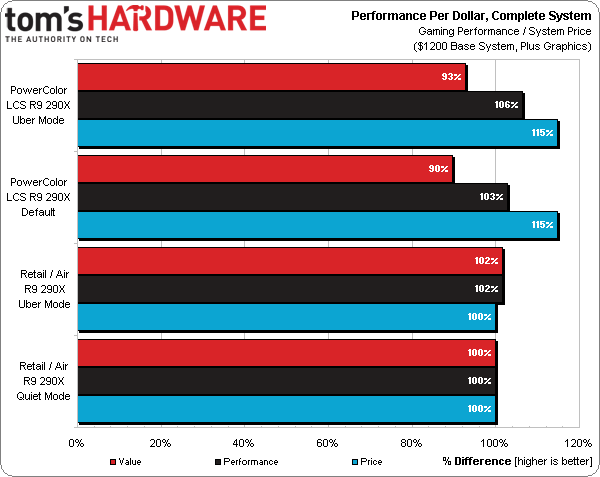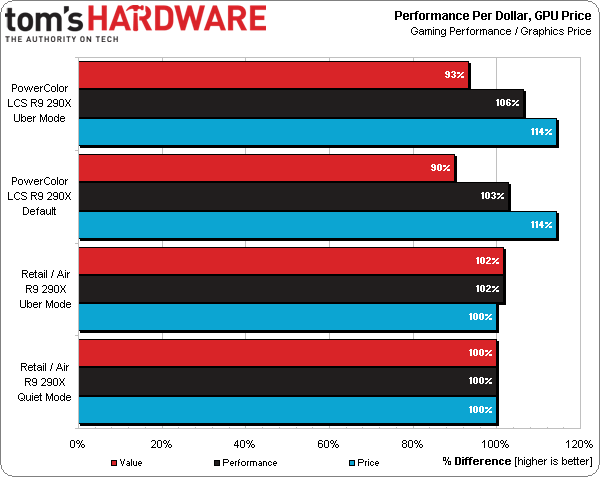PowerColor LCS AXR9 290X: Water Makes Hawaii Comfortable
AMD’s Radeon R9 290X is an incredibly powerful gaming card. Unfortunately, the company's cheap cooling solution results in inconsistent performance and excessive noise. PowerColor’s liquid-cooled LCS AXR9 290X is set to solve both issues with finesse.
Putting A Price On Silence
With a GPU that’s factory-overclocked by 6%, PowerColor’s LCS AXR9 290X 4GBD5-WMDHG/OC sets the example of liquid-cooled value by being priced only $100 higher than the card we compared. Yet, one of the reasons this $800 offering looks like such a good deal (relatively) is that its $700 air-cooled rival is currently overpriced. We'd hope to see the gap between them widen as the prices on 290X cards fell back to AMD's launch prices, but we're not holding our breath, either.
Price volatility aside, our LCS AXR9 290X sample was also able to reach a 1200 MHz overclock silently. The optimized fan profile required to hold the air-cooled card at 1120 MHz pushed system noise up from 31 dB (stock) to 45. And that's a best-case scenario using Nanoxia’s Deep Silence 1 enclosure to stifle noise, in an 18 to 19 °C room. I pity the enthusiast in a warm environment.
A 6% performance improvement is hardly worth a 15% price increase, but the above chart also includes the $180 worth of liquid-cooling hardware that we added to make the LCS AXR9 290X function. If you already own a large enough loop to add this card, you’ll find value parity between PowerColor's $800 board and the $700 air-cooled retail card when you add them both to a $1200 system.
Amazingly, the price-per-performance of the card alone is similar to its value when added with a $180 pump and radiator combo to a $1200 PC.
The real added value of liquid-cooling a Radeon R9 290X doesn't necessarily come from increased performance though, but decreased noise. You can get most of the speed-up by simply turning up the clock rates and cranking the fan speed on an air-cooled card to annoying levels. Unfortunately, the worth of less noise depends on the liquid-cooling components you're using, making any attempt to quantify this completely arbitrary. Our charts are the closest approximation we can find without dollars-to-noise compensation.
The liquid-cooling sink used on PowerColor’s LCS AXR9 290X is definitely worth something over AMD’s maligned reference heat sink and fan, but is the card ultimately worth $800? We believe that all Radeon R9 290X graphics cards are currently overpriced, unless you’re making money off them in crypto-currency mining, in which case there's a good chance you're getting hammered on power costs. Really though, any Hawaii-based card has the potential to re-emerge a value leader once supply catches back up to demand.
Sidestepping the question of value, which market forces affect on an almost-daily basis, we find that it's better to ask if we'd spend an extra 14% to rid ourselves of the reference card’s heat and noise issues. The answer is an easy yes.
Get Tom's Hardware's best news and in-depth reviews, straight to your inbox.
-
AMD Radeon really? $800?Reply
$100++ from GTX 780 Ti
http://pcpartpicker.com/parts/video-card/#sort=a7&qq=1&c=153 -
Crashman Reply12815459 said:really? $800?that's more than $150 from Asus DCU IIhttp://pcpartpicker.com/parts/video-card/#c=146&sort=a7
It has a $150 cooler (including the back plate, etc).
Of course Asus has a special cooler too. But Asus had the opportunity to drop its price, and the 290x has indeed dropped by $50 to $100 in the past two weeks. Supply is catching up with demand.
Unfortunately for PowerColor, its LCS 290X has been out-of-stock for more than two weeks. So they get stuck with prices that are at least two weeks old, at least until someone gets new inventory and lowers their price.
Sucks to be them, they should have restocked their sellers more quickly :)
But it's still cheaper than a water-cooled 780 Ti :)12815459 said:really? $800?
$100++ from GTX 780 Ti
http://pcpartpicker.com/parts/video-card/#sort=a7&qq=1&c=153 -
outlw6669 Great review Tom!Reply
Did you happen to notice any variability under load for your core speed while overclocked on the LCS card?
I have a Sapphire Tri-X OC R9 290X that is rock solid at its stock 1040MHz, but that starts bouncing the core clock all around when any core overclocking is applied.
With my quiet fan curve, load temps top out around 85°C; well below AMD's specified throttle point of 95°C.
If your liquid cooled cards are solid at 1200MHz, I am curious if Power Tune starts to throttle in a less severe way after going above 70- or 80°C. -
AMD Radeon Reply
Thanks for the explanation, very good review overall :)btw sorry I edited my comment before you posted
It has a $150 cooler (including the back plate, etc).Of course Asus has a special cooler too. But Asus had the opportunity to drop its price, and the 290x has indeed dropped by $50 to $100 in the past two weeks. Supply is catching up with demand.Unfortunately for PowerColor, its LCS 290X has been out-of-stock for more than two weeks. So they get stuck with prices that are at least two weeks old, at least until someone gets new inventory and lowers their price.Sucks to be them, they should have restocked their sellers more quickly :)12815459 said:really? $800?that's more than $150 from Asus DCU IIhttp://pcpartpicker.com/parts/video-card/#c=146&sort=a7 -
TheDane Sapphire R9 290X Tri-X is (very) silent, cheaper, doesn't required a W/C setup, and installation is much easier. Also the LCS card here requires a wide case due to its height!Reply -
Crashman ReplyGreat review Tom!Did you happen to notice any variability under load for your core speed while overclocked on the LCS card?I have a Sapphire Tri-X OC R9 290X that is rock solid at its stock 1040MHz, but that starts bouncing the core clock all around when any core overclocking is applied.With my quiet fan curve, load temps top out around 85°C; well below AMD's specified throttle point of 95°C.If your liquid cooled cards are solid at 1200MHz, I am curious if Power Tune starts to throttle in a less severe way after going above 70- or 80°C.
Power throttling occurs under Furmark and not much else, and can be eliminated by increasing the power threshold.
...and toasts your CPU. Please read the first page of this review, thanks!12815581 said:Sapphire R9 290X Tri-X is (very) silent, cheaper, -
outlw6669 Reply
Odd, this happens with a +50% power limit and tested with the Metro Last Light benchmark :/12815634 said:Power throttling occurs under Furmark and not much else, and can be eliminated by increasing the power threshold.
Thanks for confirming that your test card was not throttling; back to troubleshooting my setup! -
Crashman Reply
Remember that the LCS test card runs cooler than an air-cooled card, and that lower temperatures significantly lower power consumption :)12815667 said:
Odd, this happens with a +50% power limit and tested with the Metro Last Light benchmark :/12815634 said:Power throttling occurs under Furmark and not much else, and can be eliminated by increasing the power threshold.
Thanks for confirming that your test card was not throttling; back to troubleshooting my setup!
-
outlw6669 Reply12815705 said:Remember that the LCS test card runs cooler than an air-cooled card, and that lower temperatures significantly lower power consumption :)
Good point; I will have to retest with a cooler fan curve.
Not sure if this will be the issue though as even a 20MHz bump to the core, and +50% power limit added to this, causes throttling with under 85°C temps.
Thanks for the thoughts! -
ddpruitt ReplyAs air temperatures climbed into the 20s (Celsius) inside the case
Actually with a low room temp it'll still affect results quite a bit. I can push higher clocks in the winter with a lower room temp than in the summer (and forget it when we hit 40C, no OCing unless the Air's cranked up all the way). You might want to retest once you're able to heat up the office to see how the temps are affected (both on the air cooled and water cooled setups).



